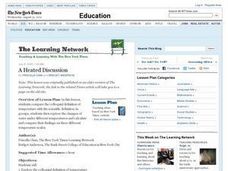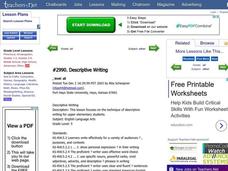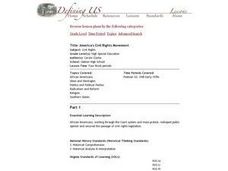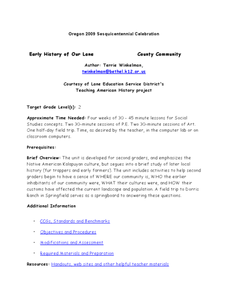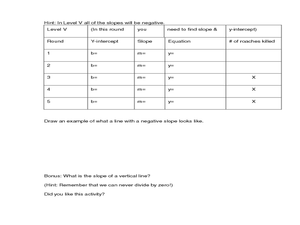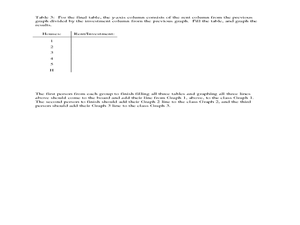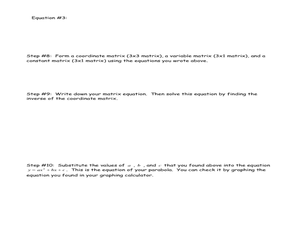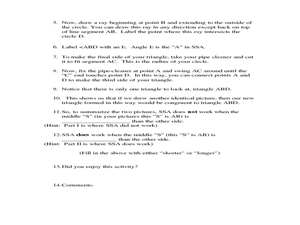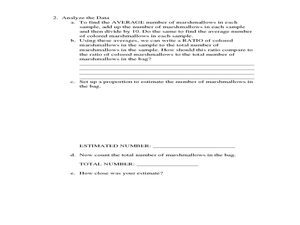Curated OER
A Heated Discussion
Young scholars compare the colloquial definition of temperature with the scientific definition. They, in groups, then explore the changes of water under different temperatures and calculate and compare their findings on three different...
Curated OER
That's So Square
Students familiarize themselves with the three most common geometric shapes: circles, triangles and parallelograms. They sketch, sort, and name the shapes.
Curated OER
What's the Matter? (Grades 6-7)
Learners explain the physical properties of matter. They, in groups, perform a variety of experiments, each demonstrating a different property of matter. A very nice, hands-on lesson!
Curated OER
Descriptive Writing
Students discuss the importance of using adjectives in writing. They separate into five groups, each group is given a bag with an object inside to describe using just one sense. They write a description of a Hershey's Kiss using adjectives.
Curated OER
Thermal Expansion
Learners examine how thermal expansion of water can affect sea level. They conduct an experiment that demonstrates what happens to water levels when exposed to heat, record the results on a data sheet, and discuss the results.
Curated OER
Extraction of Caffeine from Tea Leaves
Students conduct an experiment in which they extract the greatest number of grams of caffeine from four bags of tea. They conduct Internet research, conduct the experiment, and record their observations and data.
Curated OER
Grade 1: More Land or Water?
First graders listen as the teacher reads a story involving cross-continent traveling. Students collect a random sample by tossing an inflatable globe and recording whether they touch land or water each time they catch the globe in order...
Curated OER
Barrier Islands
Third graders explore how barrier islands work. In this erosion lesson, 3rd graders create barrier islands in stream tables and simulate wave action to see how it affects their island.
Curated OER
Paper Mosaics
Third graders read the story "Pompeii...Buried Alive." They locate Italy on a world map and define the term artifact. Students conduct an artifact dig on the playground. Students study the characteristics of mosaics and their...
Curated OER
The Effects of Temperature Variations on the Heartbeat Rate of Daphnia
Students use DigiScope technology to investigate Daphinia, popularly known as water fleas. They design, conduct, and report on an experiment to determine the effects of varying water temperatures on the heartbeat rate of Daphnia.
Curated OER
America's Civil Rights Movement
Eleventh graders explore, analyze and study the background to America's Civil Rights Movement through the court system, mass protest, public opinion, political cartoons and legislation. They research Rosa Parks, Brown vs. Board of...
Curated OER
2005 USDA Food Guide
In this food pyramid worksheet, 4th graders will answer 6 multiple choice questions about the newest version of the food pyramid (released in 2005), compare and contrast the old and new food guide using a Venn diagram, write a brief...
Curated OER
Meat Processing
In this meat processing worksheet, students learn how nitrates are used as curing agents for meat and how tenderizers work. Kids compare meat treated with nitrates with meat that has not been treated. Students complete 8 short answer...
Curated OER
What The Peanuts Say: Catabolism and Calories
Students investigate the energy released by a peanut and a piece of a walnut. In this catabolism and calories lesson plan, students burn a peanut and a piece of a walnut and measure the temperature of the water before burning and after...
Curated OER
States of Matter For Grades Kg-8
Students conduct studies of states of matter. In this science lesson plan, students observe the properties of matter and classify different substances as solids, liquids, and gases.
Curated OER
Early History of Our Lane
Second graders study Native American Kalapuya culture. In this American History lesson, 2nd graders discover the early inhabitants of their community. They take a field trip to Dorris Ranch.
Curated OER
Roll Away Trees
First graders participate in a simulation involving newspaper, food coloring, water, and more to observe the debarking process of producing wood. In this wood lesson plan, 1st graders also measure, and learn about reducing, reusing, and...
Curated OER
Cockroach Slope
Students identify the slope of linear functions. In this slope lesson, students collect data and graph it. They write equations with no more than two variables and use technology to explain their data.
Curated OER
Monopoly Graphs
Students relate the concepts of linear functions to the game of monopoly. In this algebra lesson, students solve problems with ratio and proportion. They collect data and graph it.
Curated OER
Perpendicular Lines in the Coordinate Plane
Students investigate the relationship between perpendicular and parallel lines on a coordinate plane. In this geometry lesson, students differentiate lines based on their slopes.
Curated OER
Quadratic Equations and Parabolas
Students graph and solve quadratic equations. In this functions lesson, students analyze a quadratic equation using three points on a curve to define the graph of a quadratic function. They find the vertex and intercepts of the graph.
Curated OER
Why Doesn't SSA Work?
Students investigate the relationship between angles and their sides. In this geometry lesson, students prove why SSA does not work as a true angle side relationship theorem.
Curated OER
You Sank My Battleship
Students apply the concept of transformation to the game of battleship. In this algebra lesson, students relate their linear equations to how they would graph or set up their game pieces to win.
Curated OER
Estimating Deer Population
Students calculate the deer population using proportion. In this algebra lesson, students apply the concept of ratio and proportion to real life scenario.
Other popular searches
- Writing Cubing Activities
- Cubing Activities English
- Cubing Activities as Review
- Cubing Activities in Health


